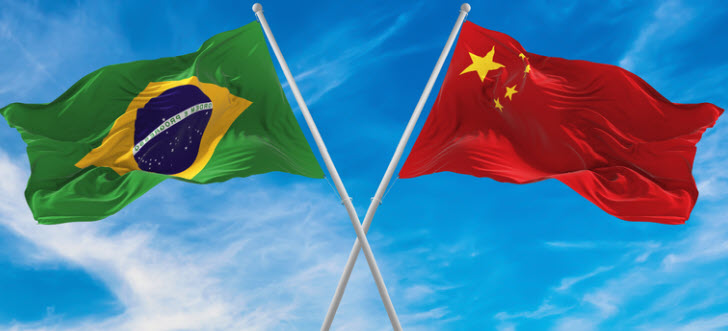The Brazilian mega-delegation that traveled to China last week included several business people, seven ministers, five governors, 27 legislators, and, of course, President Luiz Inácio Lula da Silva.
While Lula’s comments on the war in Ukraine perhaps received the most attention in the Western press, the trip also saw his government’s relations with its largest trading partner reordered.
In Beijing, Brazil and China signed a series of memoranda and agreements that, according to official figures, are worth tens of billions of US dollars.

Lula has a lot of experience dealing with China and approached the country during his two previous presidential administrations from 2003 to 2010.
During that time, the two countries signed a strategic partnership agreement, saw a surge in bilateral trade and investment, and formed the BRICS group with Russia, India, and South Africa.
At the time, Lula and his advisors celebrated the growing relationship between Brazil and China.
But some in Brazilian foreign and economic policy also began questioning whether Brazil was cautious enough in its bilateral trade with China.
The fine print of the agreements signed last week suggests that these concerns have shaped the new Lula administration’s approach to Beijing.
During Lula’s first term, China had an overwhelming appetite for Brazilian commodities such as soybeans, iron ore, and oil.
However, some producers of Brazilian manufactured goods reported difficulty selling in the Chinese market.
At the same time, the share of manufacturing in Brazil’s GDP was shrinking rapidly.
When Brazil’s Ministry of Foreign Affairs published a collection of essays on Brazil-China relations in 2011, many debated whether economic ties with China would contribute to Brazil’s deindustrialization.
Scholars have warned that premature deindustrialization is risky for developing countries.
Many countries that have risen from poor to rich built up their manufacturing sectors first and only began to leave them behind as people migrated to high-skill, well-paying jobs in other sectors.
Brazil took the first part of this path from the 1950s to the 1980s, when sectors such as metalworking, automobile manufacturing, textile production, and heavy machinery manufacturing grew.
However, in parts of the developing world where premature deindustrialization occurs, such as Brazil, people often leave the industrial sector to take low-paying, low-productivity jobs instead of higher-paying ones.
For example, a former factory worker may now work as a cashier, Uber driver, or street vendor.
A whopping 39% of Brazilian workers now work in the informal sector.
A 2022 paper by economist and China expert Tatiana Rosito and Vinicius Mariano de Carvalho of Kings College London – both of whom are Brazilian – contends that, while Brazil and China have pursued a “successful complementary agenda,” trade data over the past two decades show that Brazil “has not been able to diversify its exports to China significantly.”
Rosito now has a chance to change course: she and others who have advocated refining Brazil’s strategy toward Beijing have been appointed to senior positions in the new Lula government.
Among the new faces in Brasília is Tatiana Prazeres, the foreign trade secretary of Brazil’s Ministry of Development, Industry, Trade, and Services.
Prazeres explained that the new government is seeking Chinese expertise and investment in Brazil to promote a “neo-industrialization of the country” focused on green technologies and other high-tech sectors.
She called these the “industries of the future.”
According to a report by the China-Brazil Business Council, Brazil was the largest recipient of Chinese direct investment in 2021.
According to the group’s calculations, Chinese investment in Brazil between 2007 and 2021 flowed mainly into the electricity and petroleum sectors, and the two countries are planning a joint investment fund for green energy.
One memorandum signed last week provides funding for projects involving technology transfer.
Agreements were also announced that include a green hydrogen power plant, offshore wind projects, the latest phase of a jointly produced satellite program, a pledge to help Brazilian startups market their products in China, and a plan to create a binational agricultural logistics company.
Many of the ideas announced are “still declarations of intent” rather than concrete plans, according to University of Johannesburg economist Paulo Morceiro, “but they are generally positive.”
He said Brazil should take advantage of the fact that it has many minerals needed for the energy transition, “and China has the technology.”
But the Lula government’s frequent statements about new industrial policies – whether in partnership with China or not – make some economists nervous.
According to economist Emanuel Ornelas of the Getúlio Vargas Foundation, such policies are very difficult to calibrate successfully.
He stressed that the current talk about industrial policy gives him “little goosebumps,” adding that Brazil’s history is littered with failed industrial policies that led to industries “being protected for decades and surviving without becoming internationally competitive.”
Regardless of how Lula crafts his latest industrial policy, the government does not have the money to launch the multibillion-dollar green stimulus packages that are all the rage in the United States and Europe.
What it does have, however, are raw materials, a domestic market of more than 215 million people, and – if one is careful – the ability to negotiate internationally.

